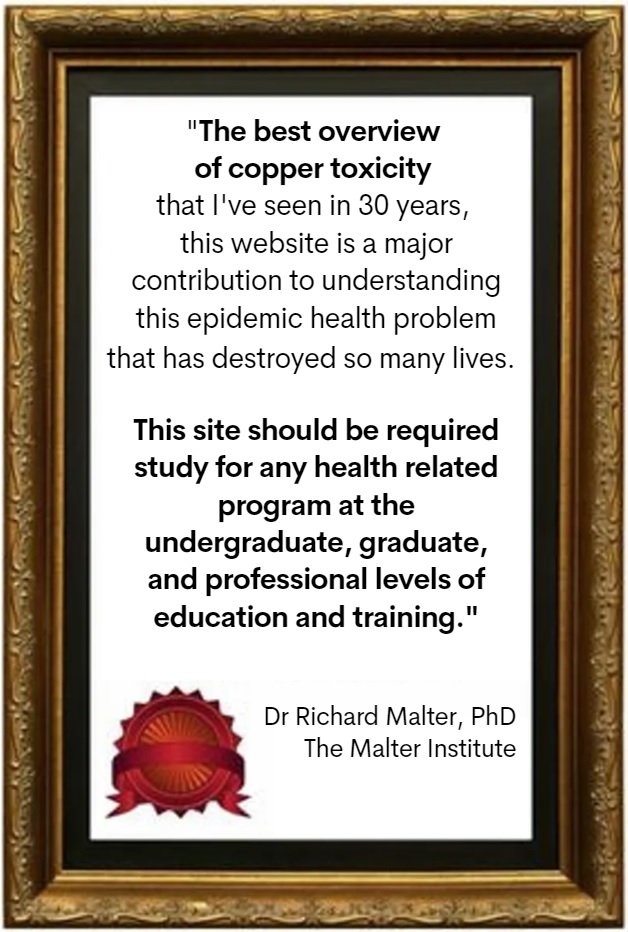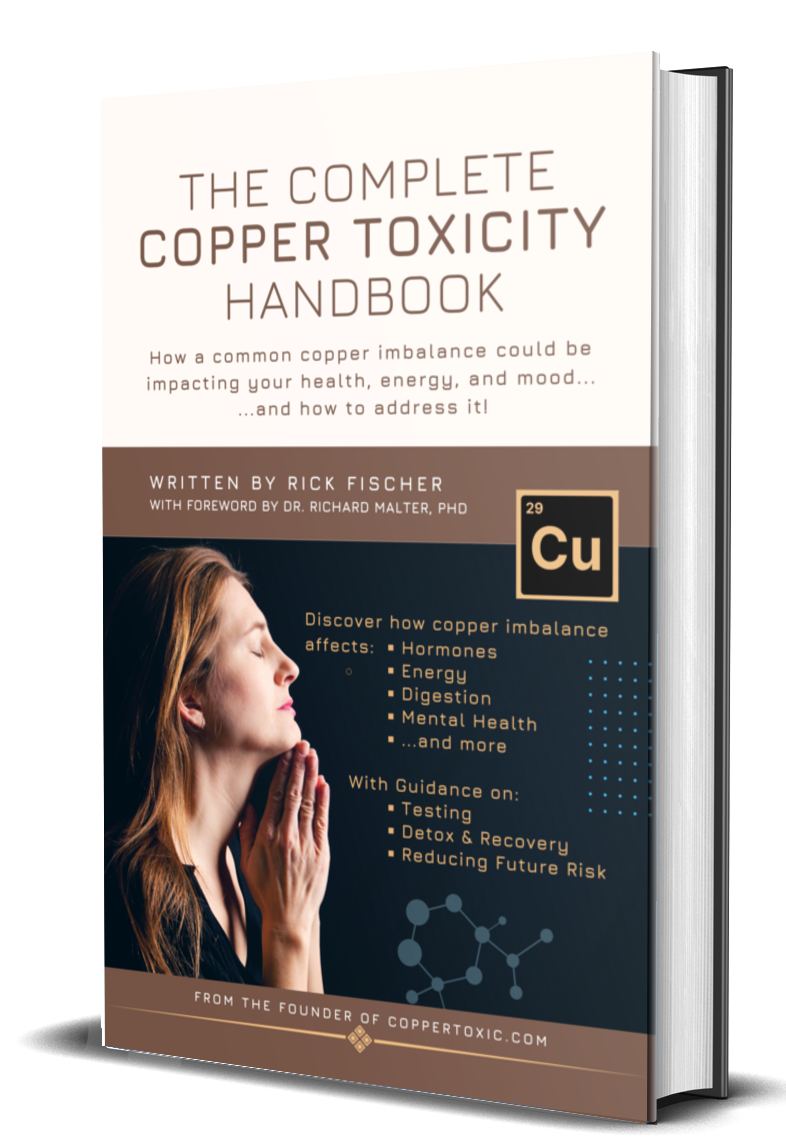CopperToxic.com
Empowering Education, Support, & Awareness for the Epidemic of Copper Toxicity.
Our Health Mission
To provide the most comprehensive evidence-based resource and support guide on copper toxicity to help those affected find clear answers; to provide research and education to both the medical community and general public on the topic; to turn the tide of awareness so women may one day receive the fully informed consent they deserve before being put on birth control, and to increase professional and social support for all those affected.
When this site was launched in 2014, very little support or information on this topic was available to the public. Through this site and our continued efforts, we are proud to see education surrounding mineral imbalances and copper toxicity being recognized and adopted by more and more health care professionals, while those affected are today more easily able to find answers and support.

"Many of the most prevalent metabolic dysfunctions of our time are related in some way to a copper imbalance." ~Dr. Paul Eck
What is Copper Toxicity? In Summary...
-
Copper Toxicity develops from a buildup of stored bio-unavailable copper in the body. The liver is the primary storage location, with the brain the secondary location of copper accumulation. Copper can also be found in the heart, kidney, pancreas, spleen, lungs, bone and muscle.
-
Birth control pills, copper IUDs, vegetarian diets, copper piping, and estrogens are just some of the contributing factors that have made copper toxicity a growing epidemic.
-
Actual dietary consumption of copper itself (aside from extreme doses) is typically not a cause of copper toxicity. The fact that some healthy people consume higher amounts of copper adds to the dismissal of copper toxicity, even though milligrams consumed have very little relevance to this condition developing.
-
Copper toxicity doesn't always show up in a blood test, due to blood’s natural self-regulating homeostatic nature. This means the standard term hypercupremia (meaning ‘high copper in blood’) fails to account for the true extent of this imbalance. The vast majority of copper toxicity cases would be considered “sub-clinical” and under-recognized - especially when blood within range is used as the determining marker.
-
Copper is an essential nutrient and offers many health benefits at a healthy level. The one-sided promotion of only copper's benefits further adds to why the idea of 'toxicity' gets ignored. Unfortunately, with toxicity, often the benefits provided by a healthy level reverse. Take, for example, copper's promoted benefit as an antioxidant, yet: "Copper is both a pro-oxidant and an antioxidant. Its antioxidant activity has been attributed to increased CuZnSOD activity ...[but] ... copper excess can induce oxidative damage to DNA." [1]
-
When unbound to other molecules, copper is a potent oxidant, conferring toxic potential, even contributing to cell death (cuproptosis).
-
Not all copper (or levels thereof) is ‘safe’. For example, copper sulfate used on crops for example is a known toxin. "Excess copper is poisonous to all forms of life, and copper overloading is responsible for several human pathologic processes" [2]. “Copper becomes toxic when it accumulates in the body's tissues in excessive amounts” (Pfeiffer, 1975; 1987). Tolerance is also very individual.
-
Copper nanoparticles ( included in various medical and dental applications) also have toxic qualities. For example, "“Copper oxide (CuO) nanoparticles (NPs) are known to trigger cytotoxicity” [3]
"“The neurotoxicity of Cu-NPs deserve attention, since these NPs have considerable cytotoxicity and can cause long-term effects " [4] -
The higher the degree of copper accumulation and/or toxicity, often the higher the degree of bioavailable deficiency.
-
Detoxing copper often brings to the surface some of the worst symptoms, if not done gently. It's therefore wise to approach detox slowly and gently to avoid / reduce anxiety, panic and other uncomfortable reactions
-
Copper deficiency is commonly talked about. Yet, a deficiency of bio-available copper can exist at the same time as excess levels are stored in the body. For many, the answer is not always to supplement more copper, but rather support copper metabolism and the body's ability to utilize copper safely.
-
Copper toxicity is a widespread yet one of the most misunderstood and suppressed epidemics of our time. It is a common factor in many of today's most prevalent conditions and should therefore at least be considered in the investigation of any of its associated symptoms.
Terminology
Copper toxicity may sometimes be referred to as hypercupremia, though it is a misleading term since hypercupremia literally translates to mean 'high copper concentration in the blood' even though blood levels are almost entirely irrelevant in assessing copper toxicity. Symptoms of copper toxicity can very much exist even when blood levels are normal or low.
Another term being used recently, copper dysregulation, while it eludes to the body's inability to regulate copper due to low ceruloplasmin, comes from a narrow-minded view which fails to address the bigger picture of why we have this epidemic in the first place, not to mention it completely ignores copper’s proven toxic attributes at high levels. Copper toxicity, as research has shown since the 1970s, is far more than just a dysregulation issue that can be ‘fixed’ by regulating ceruloplasmin. Our modern epidemic of copper toxicity is largely the result of ever increasing exposure to copper with each new generation over the past half century, a concept of paramount importance that tends to be trivialized by using the term ‘dysregulation’.
Copper toxicity, in the context of this site, differs somewhat from Pyroluria (a genetic condition in which the individual produces excess kryptopyrrole which in turn causes B6 and zinc deficiency). While pyroluria can lead to copper toxicity, not all copper toxicity is caused by pyroluria. Copper toxicity, though sharing some similarities with Wilson's Disease, is also different in that the latter is an inherited & rare genetic disorder which, like copper toxicity, causes copper to collect in the liver, brain and other body tissues, but has a more dire prognosis than copper toxicity, and for which a different treatment approach is required.
"Virtually all MDs, including psychiatrists, still have not heard of this health problem. They practice medicine and psychiatry with an incredible lack of awareness that such a serious health problem even exists. They claim to be practicing “evidence based medicine”, yet they are practicing without the most basic evidence – real laboratory data showing the presence of excess (toxic) copper that has a profound effect on both the physical and mental health of the vast majority of their patients. Ever since Carl Pfeiffer, MD, PhD first wrote about the devastating health effects of copper toxicity in 1975, it has been a challenge for him and others among us to get the message out to the public and health professionals. Until medical doctors and other “health” care practitioners begin to study the mind/body’s mineral system especially as it is reflected in HTMAs, the medical / mineral disconnect will remain. Without HTMA data, medical doctors will not recognize the epidemic nature of the copper toxicity problem. Today, the time is ripe for getting the copper toxicity message out to the public."
~Dr. Richard Malter, PhD
Get Your Digital Copy...
"The Complete
Copper Toxicity Handbook"
TOGETHER, WE CAN INCREASE AWARENESS AND MAKE A DIFFERENCE. Receive your eBook copy of this seminal book on Copper Toxicity (including all the info on this website and more) with any donation.

_________________________
References on this Page:
[1] Bo, S., Durazzo, M., Gambino, R., Berutti, C., Milanesio, N., Caropreso, A., Gentile, L., Cassader, M., Cavallo-Perin, P., & Pagano, G. (2008). Associations of dietary and serum copper with inflammation, oxidative stress, and metabolic variables in adults. The Journal of Nutrition, 138(2), 305–310. https://doi.org/10.1093/jn/138.2.305
[2] Macomber, L., & Imlay, J. A. (2009). The iron-sulfur clusters of dehydratases are primary intracellular targets of copper toxicity. Proceedings of the National Academy of Sciences of the United States of America, 106(20), 8344–8349. https://doi.org/10.1073/pnas.0812808106
[3] Gupta, G., Cappellini, F., Farcal, L., Gornati, R., Bernardini, G., & Fadeel, B. (2022). Copper oxide nanoparticles trigger macrophage cell death with misfolding of Cu/Zn superoxide dismutase 1 (SOD1). Particle and Fibre Toxicology, 19(1). https://doi.org/10.1186/s12989-022-00467-w
[4] Agarrayua, D. A., Silva, A. C., Saraiva, N. R., Soares, A. T., Aschner, M., & Avila, D. S. (2023). Neurotoxicology of metals and metallic nanoparticles in Caenorhabditis elegans. In J. Batista Rocha, M. Aschner, & L. G. Costa (Eds.), Advances in Neurotoxicology (Vol. 9, pp. 107–148). Elsevier.
© Copyright © 2014-2024 CopperToxic.com - All Rights Reserved.
Reproduction and distribution of material on this website without written permission or clear and proper attribution is strictly prohibited.

